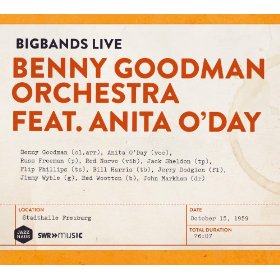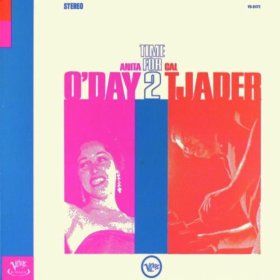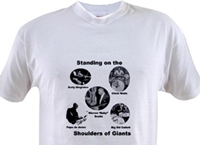
I accidentally came across this gem while looking for something completely different. A quick listen to the sound samples on this page convinced me. What a delightful surprise and some amazing music.
There are short sound samples on this page, so you can let your own ears determine if this is for you. What those samples will not tell you is which of the tracks contains Anita because she does not come in until after the intros in the samples. She is on these tracks:
- Honeysuckle Rose
- Come Rain or Come Shine
- Let Me Off Uptown
- Gotta Be This Or That
- Girl Crazy, Act II: But Not for Me/Four Brothers/Blues
It's uncertain whether Anita was supposed to be on Gotta Be This Or That. It starts off with Benny singing, then forgetting the lyrics and trying to scat is way through the rest. That alone is priceless, but when Anita joins in and 'rescues' him the song takes on a life of its own.
Let Me Off Uptown lacked the fire of Anita's performances with Roy Eldridge, but was still a great addition to the album.
The rest of the ensemble was comprised of Russ Freeman on piano, Red Norvo on vibes, Jack Sheldon on trumpet, Flip Phillips on tenor sax, Bill Harris on trombone, Jerry Dodgion on flute, Jimmy Wyble on guitar, Red Wootton on bass and John Markham on drums.
Norvo's quiet, vibrato-less style of playing is a marked contrast to Lionel Hampton's aggressive, full vibrato playing which is usually associated with Benny's clarinet. However, it perfectly fit the ensemble. I was also impressed by John Markham's drumming, which reminded me a lot of Anita's own drummer, John Poole (who was on the tour as Anita's manager.)
For those who track dates, places and other details of jazz performances, this was about mid way through Goodman's 1959 European tour, which kicked off in Munich on 3 October 59. This album is the Stadthalle-Freiburg performance of 15 October, a week before the tour ended.
Here is the same ensemble three months later back in the US. In this clip Gene Dinovi replaces Russ Freeman on piano, however the same energy is exhibited and this is another indication of the quality of music on the album:
Anita discussed this tour and problems she and Benny had in Chapter XI, pages 244-246 of High Times Hard Times. Benny never liked being upstaged and therein was the cause of the clash. That, plus Benny was straight-laced and Anita was truly the Jezebel of jazz and a strong personality in her own right. When Benny informed her to not show up for one of the performances on the tour she threatened to quit, so he pared down her performances to just two songs per appearance. Given the fact that this album contains five songs, it must have been recorded before the clash.
There are two other albums from this tour: In Stockholm 1959, from 18 October 59 with a smoking performance of Four Brothers with Stan Getz who sat in, and An Airmail Special From Berlin 1959 from 22 October. Both are worth checking out if you enjoy this one.
The next album that I consider a hidden gem is Anita O'Day And The Three Sounds

When this album was cut in 1963 with The Three Sounds (a popular trio from that era), it was not widely accepted by fans. I'll be honest - I was also lukewarm the first few times I listened to this album. It seemed to lack that ineffable quality and verve (no pun intended) that Anita brought to her performances, both live and in the studio.
My first thought was to make a wine analogy where some of my favorite O'Day albums were like a complex Valpolicella whereas this one was line the second glass of a table wine. In the first you could savor the nuances; in the second the complexity and nuances were not really there, but you still felt good. After many hours of enjoying this album, though, I realize my wine analogy was not only glib and snobbish, but off the mark. The Three Sounds did a remarkable job in supporting Anita's vocals in my opinion. Some may call it bland or even elevator music. I call it masterful because there is a nice swing and sensitive playing by the entire ensemble.
Gene Harris' piano reminds me a lot of Ahmad Jamal. There is a lot of space, and to extend the comparison further, Andrew Simpkins' bass fills in nicely the way Israel Crosby complemented Jamal in their trio playing. The wild card in the ensemble, in my opinion, is Bill Dowdy on drums. Bear in mind that not only am I a drummer who is going to naturally pay close attention to that instrument in recordings, but I am heavily influenced by John Poole, who was Anita's drummer for nearly four decades. Dowdy's playing is vastly different from Poole's, but is also very tasteful and fit the music on each track perfectly (to my ears anyway.)
The real treat and - for me - a highlight is Whisper Not, which features Roy Eldridge playing a muted trumpet solo. When I first heard the solo it immediately stood out because the album is mainly centered around Anita backed by a piano trio. When I looked up who played it took my breath away because it transported me mentally back to her Krupa days when she and Eldridge would do duets.
Another favorite is this track from the album because it showcases Anita's voice and the Three Sounds:
There is a subdued quality to Anita's vocals on this album too. In some ways she seems to be missing that joie de vivre - joy of life - quality. In other ways, she seems centered and at the beginning of a long, gradual transformation.
Perhaps I have rambled on long enough. The best way to determine if this album is for you is to listen to the sound samples on this page. They will give a tantalizing taste, but I found the real beauty of each track to be many bars into each song.
This album is the one in which I discovered the Three Sounds and because a solid fan. If you like the way they back Anita, I recommend checking out The three Sounds Eight Classic Albums.
The final gem I'll discuss in this post is a collaboration between Anita and Cal Tjader titled, Time For Two

Cream rises to the top and this album is the cream from Anita's Verve years in my opinion. While the bulk of her recordings from those years were in orchestral settings, this and a handful of others capture Anita in her best setting - a small ensemble.
In addition to the setting, another factor that makes this album the cream of the crop and a showcase is Cal Tjader's leadership of the backing ensemble. The musicians were Cal Tjader and Johnny Rae handling vibes and percussion, Bob Corwin and Lonnie Hewitt switching off on piano and Freddy Schrieber on bass.
Part of the reason for the success of this album is the shared traits between him and Anita. He was not only an acclaimed vibraphonist, but also an accomplished drummer and percussionist. Anita had a lifelong affinity for drummers, starting with the lessons she received from her first husband, Don Carter, as well as her lifelong collaboration and friendship with John Poole who was her drummer for well over three decades.
In addition to that point of musical intersection, Tjader brought to this album a strong sense of Afro-Cuban rhythms, as well as the ability to play laid back, straight-ahead jazz. The former played directly into Anita's percussive singing style, while the latter was a major comfort zone for Anita. I won't attempt to describe the music since there are sound samples on this page, but I will cite two examples of music that showcase both the Latin and the straight-ahead pieces on this album: An Occasional Man for the former and I'm Not Supposed to Be Blue Blues for the latter. The chasm between those two styles is why I claimed that the album showcases Anita's versatility. Here is a clip that gives a flavor of the infectious Latin side of the album:
A few notes about the backing ensemble: Tjader's vibe style is - to my ears - very similar to Red Norvo. It's light, airy and virtually no vibrato. That style spills over to the rest of the ensemble. The music itself comes across as simple. However, if you consider just how few musicians are present their ability to make the backing ensemble sound much larger is a feat in itself. Not only that, but they perfectly support Anita, providing her with a rhythmic platform that leaves the melody to her and Tjader's vibraphone.
One final clip from the album to savor:
Of all of Anita's Verve albums, the two that I think rise to the top for small group excellence is this one and Anita O'Day And The Three Sounds discussed above. For pure magic, though, this one is my favorite.



No comments:
Post a Comment